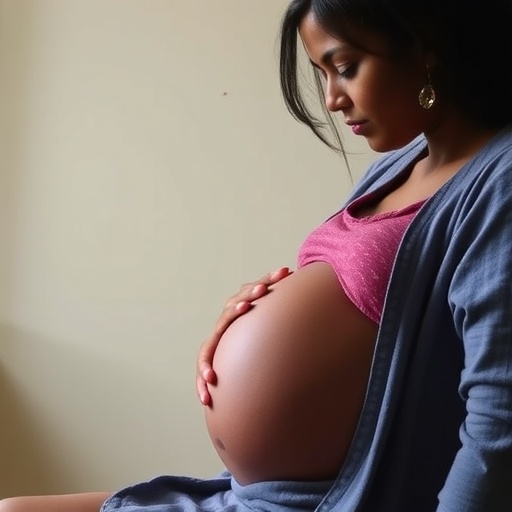A recent cross-sectional study published in JAMA Network Open delves into the complex interplay between maternal nativity and prenatal mental health, uncovering nuanced patterns of prenatal depression across diverse racial and ethnic groups. This research propels us into fresh territory by questioning previously held assumptions about the universality of health advantages observed in non–U.S.-born mothers, especially in the context of mental health during pregnancy. Highlighting the disparities in prenatal depression diagnoses and symptom severity, the study invites the scientific community to reconsider how sociocultural factors mediate mental health risks among pregnant individuals.
Maternal nativity, or whether a pregnant individual is U.S.-born or foreign-born, has long been recognized as a significant determinant in perinatal outcomes. Prior literature often identifies a “healthy immigrant effect,” a phenomenon where non–U.S.-born mothers display favorable maternal and neonatal health outcomes relative to their U.S.-born counterparts. However, this new investigation challenges the uniformity of this advantage by revealing that such benefits may not extend to prenatal mental health conditions. Specifically, the prevalence of diagnosed depression and the incidence of moderate to severe depressive symptoms diverged notably across racial and ethnic groups depending on nativity, suggesting that biological and social determinants converge in more intricate ways than previously assumed.
Employing a rigorous cross-sectional design, the study analyzed data encompassing diverse populations categorized by race, ethnicity, and maternal nativity status. Such demographic stratification is pivotal, as it allows researchers to isolate the intersecting influences of culture, migration history, and psychosocial stressors on prenatal depression. The authors underscore the importance of nuanced diagnostic approaches, as depression may manifest and be reported differently across cultural contexts, thereby complicating epidemiological assessments.
From a clinical psychology standpoint, prenatal depression represents a significant risk factor not only for maternal well-being but also for adverse neonatal outcomes. Elevated levels of depressive symptoms during gestation have been linked to preterm birth, low birth weight, and developmental challenges in offspring. Therefore, identifying at-risk groups through sociodemographic lenses such as nativity and ethnicity holds substantial implications for targeted intervention and healthcare equity.
One of the compelling findings in the study is that non–U.S.-born mothers, despite generally faring better in various health domains, did not uniformly show lower rates of prenatal depression across all racial and ethnic groups. This nuance suggests that protective factors traditionally associated with immigrant status—including strong familial networks, cultural resilience, and health behaviors—may be insufficient or unevenly distributed in mitigating prenatal mental health disorders. It also raises concerns about potential underdiagnosis or cultural stigma interfering with accurate detection of depressive symptoms in certain subpopulations.
The study’s revelations prompt a critical reevaluation of current prenatal screening protocols and mental health services. Healthcare providers may need to adopt culturally sensitive screening tools and develop outreach strategies that recognize the heterogeneity within immigrant populations. Tailoring care to accommodate linguistic barriers, migration-related stressors, and culturally embedded expressions of psychological distress is essential to closing gaps in perinatal mental health equity.
Sociocultural factors emerge as pivotal axes shaping prenatal depression risks. Migration experiences—ranging from voluntary immigration to forced displacement—intersect with systemic barriers such as access to healthcare, socioeconomic status, discrimination, and social isolation. These variables can compound psychological stress, thereby increasing vulnerability to depression during pregnancy. The study advocates for future research agendas that dissect these sociocultural determinants, aiming to elucidate mechanisms linking maternal nativity with prenatal mental health trajectories.
Furthermore, this work contributes to the burgeoning discourse on health disparities and social determinants of health within obstetrics and neonatology. By situating prenatal depression within the broader context of racial and ethnic health inequities, the study propels a multidisciplinary approach encompassing anthropology, psychology, and public health. This integrative perspective is critical for designing interventions that respect the cultural and social milieu of diverse maternal populations.
Methodologically, the employment of observational, cross-sectional data provides a snapshot of associations between nativity and depression symptoms, but the authors acknowledge inherent limitations regarding causality. Longitudinal studies are recommended to track the evolution of mental health across pregnancy stages and postpartum while controlling for confounding variables. Such data would enhance our understanding of how nativity-related factors temporally influence depression onset and severity.
Public health implications of these findings are profound. Given the growing diversity in the U.S. maternal population, healthcare systems must anticipate and adapt to multifaceted risk profiles for prenatal depression. Policies that bolster mental health screening in prenatal care settings, coupled with culturally responsive psychosocial supports, are urgently needed to mitigate adverse outcomes. Moreover, community-based participatory research may engage immigrant communities directly to co-create effective interventions.
The publication also emphasizes the need for heightened awareness among clinicians regarding potential biases and gaps in prenatal depression diagnosis. Differential symptom expression or reluctance to disclose psychological distress due to stigma could contribute to under-recognition in immigrant groups. Training programs aimed at cultural competence and the deployment of validated screening instruments sensitive to ethnic and linguistic diversity are important strategic priorities.
In summation, this landmark study opens compelling avenues for advancing prenatal mental health research and care by underscoring the complex intersection of maternal nativity, race, ethnicity, and cultural context. It challenges simplistic paradigms of immigrant health advantage and calls for a sophisticated understanding of how sociocultural realities shape psychological well-being during pregnancy. As research continues, integrating these insights promises to enhance clinical outcomes and foster equity in maternal and neonatal health.
For media inquiries or further information, the study’s corresponding author is Dr. Kendria Kelly-Taylor, reachable via email at kendria.d.kelly-taylor@kp.org. The full-text article will be accessible free of charge upon embargo lift, further supporting dissemination of these important findings to the scientific community and beyond.
Subject of Research: Prenatal depression diagnosis and symptom severity across racial, ethnic, and maternal nativity groups.
Article Title: [Not provided]
News Publication Date: [Not provided]
Web References: [Not provided]
References: doi:10.1001/jamanetworkopen.2025.31844
Image Credits: [Not provided]
Keywords: Depression, Ethnicity, Birth rates, Racial differences, Prenatal care, Prenatal screening, Mental health, United States population, Observational studies, Neonatology, Cultural practices, Symptomatology




